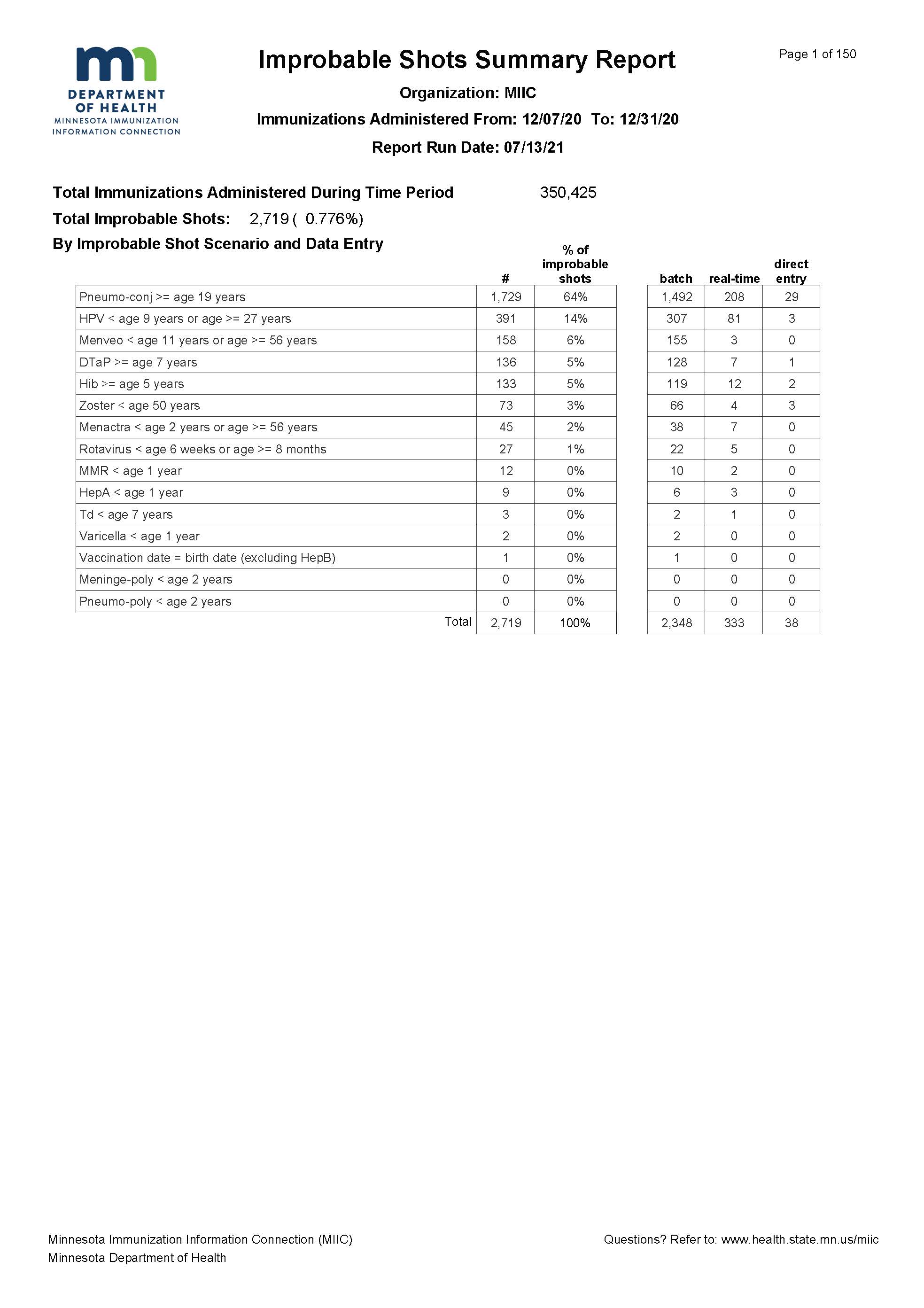Contact Info
Monitoring "Improbable Shots" in MIIC
MIIC User Guidance and Training Resources
Providers can use the Minnesota Immunization Information Connection (MIIC) immunization registry as a tool to help monitor and correct "improbable shot" vaccine administration and documentation errors. This can improve vaccine forecasting and immunization coverage rates as well as reduce wasted vaccine and potential adverse events from administration errors. Updated 9/11
What are improbable shots?
Improbable shots are vaccinations that fall outside of appropriate minimum and maximum age indications for licensed vaccines. Providers can use MIIC to identify the following improbable shot scenarios:
- DTaP ≥ 7 years
- Td/Tdap < 7 years
- Hib ≥ 5 years
- HPV < 9 or ≥ 27 years
- Menactra (MCV) < 2 or ≥ 56 years
- Menveo (MCV) < 11 or ≥ 56 years
- Meninge-poly (MPSV) < 2 years
- Pneumo-conj (PCV) ≥ 19 years
- Pneumo-poly (PPSV) < 2 years
- Rotavirus < 6 weeks or ≥ 8 months
- Hepatitis A < 1 year
- MMR < 1 year
- Varicella < 1 year
- Zoster < 50 years
- Vaccination date = DOB (excluding hepatitis B)
Improbable shots report in MIIC
Within the MIIC application, providers can run an Improbable Shots Report to see improbable shots specific to their organization at any time. The report includes a summary and a detailed output file. A sample report is shown below.
MIIC Improbable Shots Summary Report (PDF) 
The report indicates the total improbable shots attributed to the provider during a given time period and the number of improbable shots by scenario and data entry source.
At this time the MIIC report does not include "not valid" shots in MIIC, or shots given outside of appropriate dosing intervals; the report is specific to vaccinations administered outside of licensed age indications.
Where do they come from?
The improbable shots identified by MIIC may truly be vaccine administration errors or they may errors in the way the shot was submitted to the registry. For example, common vaccine administration errors include administering the MMR and varicella vaccines before a child turns one year. The first dose of these vaccines must be given on or after the child's first birthday to ensure proper protection.
On the other hand, vaccine documentation errors occur when incorrect data is entered into MIIC. An incorrect vaccine or vaccine code may be chosen in the immunization registry, a practice management system, or the electronic medical record. Common documentation errors include interchanging vaccines such as Td and DTaP and Pneumo-conj (PCV) and Pneumo-poly (PPSV). A wrong CPT code may also be selected and sent to MIIC. The CPT codes for Hepatitis A and Influenza A H1N1 vaccines are very similar, for example: 90633 and 90663.
While some improbable shot scenarios are truly administration or documentation errors, other scenarios may be okay if the vaccination was indicated by a physician.
What is their impact?
Improbable shots affect providers and patients. Identifying and correcting these errors ensures that patients are fully protected from vaccine-preventable diseases. Improbable shots may impact:
- The accuracy of patients' immunization histories and vaccine forecasting;
- Reminder-recall;
- Provider and population-based immunization coverage rates;
- Vaccine inventory; and
- Provider reimbursement for vaccines.
Because MIIC is a shared network of immunization records, providers rely on the registry for accurate and up to date immunization data. Maintaining the accuracy of the data is a shared responsibility.
Resources
Find more information on how to run and interpret the Improbable Shots Report at Running the Improbable Shots Report. If you have any questions, please contact the MIIC Help Desk.